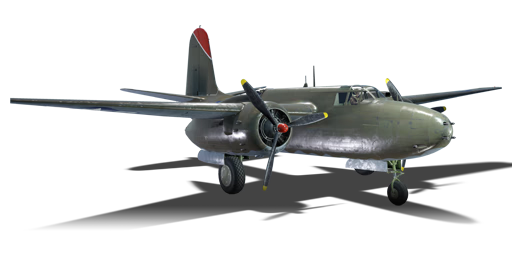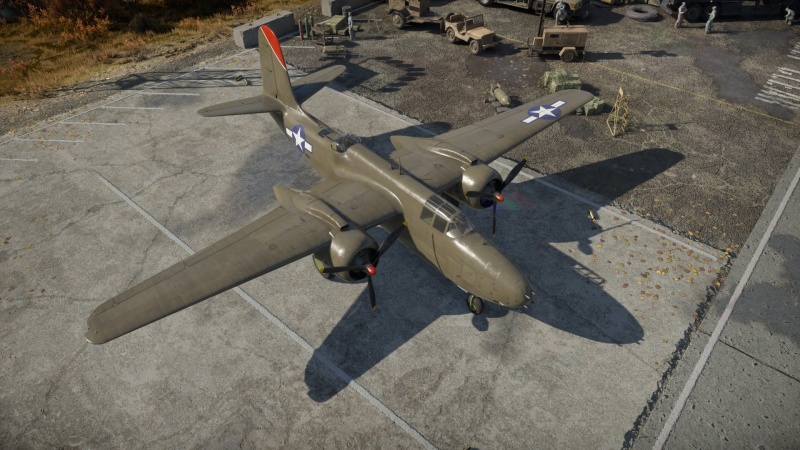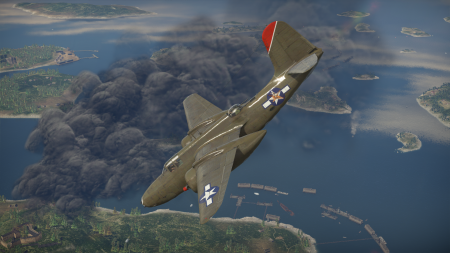A-20G-25
| This page is about the American strike aircraft A-20G-25. For other versions, see DB-7 (Family). |
Contents
Description
The A-20G-25 Havoc is a rank American strike aircraft with a battle rating of (AB), (RB), and (SB). It was in the game since the start of the Open Beta Test as the A-20G-30 before being remodelled and renamed in Update 1.47 "Big Guns" as the A-20G-25.
The A-20 is classified as a strike aircraft, which carries both good and bad traits when compared to "real" bombers. The main advantage is its strong offensive armament (comparable to that of many U.S fighters), which allows it to engage other aircraft or to strafe soft ground targets. Additionally, it carries an excellent defensive armament, with 2 x 12.7 mm machine guns mounted in a dorsal turret, and a single 12.7 mm machine gun in a hatch below the tail. However, in-game strike aircraft are treated differently than bombers, spawning at a lower altitude and in Realistic Mode, and they do not benefit from a bomb-sight.
Due to its lack of manoeuvrability, turn fighting or energy fighting enemy aircraft is extremely ill-advised, since the A-20G isn't capable of out-turning anything (even heavy fighters), and its energy retention is very poor. If one must engage an enemy fighter, either make sure to have a significant energy advantage in order to use boom-and-zoom tactics or try to provoke them into a head-on pass since not much can compete with the A-20G's armament. If an enemy plane avoids a head-on engagement, it is likely better to avoid turning, and use the speed of this plane to either get to help or to allow your gunners to engage the fighters. Often, the best defensive tactic is to stay at very low altitude to force the enemy into the dorsal turret's coverage area and hope it can deal with it, as the A-20G is hopeless in any kind of combat manoeuvring otherwise.
General info
Flight performance
| Characteristics | Max Speed (km/h at 3,048 m) |
Max altitude (metres) |
Turn time (seconds) |
Rate of climb (metres/second) |
Take-off run (metres) | |||
|---|---|---|---|---|---|---|---|---|
| AB | RB | AB | RB | AB | RB | |||
| Stock | 491 | 476 | 35.6 | 36.2 | 6.1 | 7.7 | 604 | |
| Upgraded | 532 | 510 | 32.6 | 34.0 | 15.5 | 10.1 | ||
Details
| Features | ||||
|---|---|---|---|---|
| Combat flaps | Take-off flaps | Landing flaps | Air brakes | Arrestor gear |
| ✓ | ✓ | ✓ | X | X |
| Limits | ||||||
|---|---|---|---|---|---|---|
| Wings (km/h) | Gear (km/h) | Flaps (km/h) | Max Static G | |||
| Combat | Take-off | Landing | + | - | ||
| 428 | 406 | 295 | ~6 | ~3 | ||
| Optimal velocities (km/h) | |||
|---|---|---|---|
| Ailerons | Rudder | Elevators | Radiator |
| < 260 | < 320 | < 300 | > 320 |
| Compressor (RB/SB) | ||
|---|---|---|
| Setting 1 | ||
| Optimal altitude | 100% Engine power | WEP Engine power |
| 467 m | 2,700 hp | 3,200 hp |
| Setting 2 | ||
| Optimal altitude | 100% Engine power | WEP Engine power |
| 2,906 m | 2,500 hp | 3,022 hp |
Survivability and armour
- 12.7 mm Steel - Fore cockpit armour plate
- 8 mm Steel - Fore cockpit side armour plate
- 9.5 mm Steel - Pilot's seat
- 12.7 mm Steel - Dorsal gunner's fore and aft armour plating
- 12.7 mm Steel - Ventral gunner's belly armour plating
- 12.7 mm Steel - Ventral gunner's rear armour plating
- Self-sealing fuel tanks (2 in each wing)
Modifications and economy
Armaments
Offensive armament
The A-20G-25 is armed with:
- 4 x 12.7 mm Browning M2 machine guns, nose-mounted (350 rpg = 1,400 total)
- 2 x 12.7 mm Browning M2 machine guns, chin-mounted (350 rpg = 700 total)
Suspended armament
The A-20G-25 can be outfitted with the following ordnance:
- Without load
- 4 x 500 lb AN-M64A1 bombs (2,000 lb total)
- 12 x M8 rockets
Defensive armament
The A-20G-25 is defended by:
- 2 x 12.7 mm M2 Browning machine guns, dorsal turret (400 rpg = 800 total)
- 1 x 12.7 mm M2 Browning machine gun, ventral turret (400 rpg)
Usage in battles
The A-20G-25 possesses a fairly standard loadout of 6 x 12.7 mm machine guns like many regular fighters in the U.S tech tree. However, unlike the fighters, the machine guns on the A-20 are mounted solely in the nose. This allows for a much more focused cone of fire at range since convergence is not a significant factor, meaning that the A-20G will have an easier time hitting targets, but hardened ground targets like light and medium tanks will be easier to kill due to the fact that bullets are not converging from an angle, increasing penetration.
In general, either stealth or universal belts are recommendable for most situations. While the ground targets belt does make it feasible to kill medium tanks with the 12.7 mm machine guns, the angles required for dealing damage are so specific, you end up putting a fairly unmanoeuvrable plane at risk of crashing.
Enemies worth noting:
Yak-2 KABB: Do not think that the A-20G-25 can confidently outmanoeuvre this plane just because it is twin-engined. The Yak-2 has an amazing turn rate for a heavy fighter, thus the A-20G-25 must avoid turning with it, if not dogfighting with it in general. It bears a pair of ShVAK cannons that can easily damage vital parts like engine or cooling systems. It has green camo, greatly resembling an Me 410 but with an H-tail like a Bf 110's.
ZSD63: Though it is hard to identify specific SPAA vehicles on the ground (especially when they are shooting tracers at the plane), if a ZSD63 is identified, avoid it at all costs and do not attempt head-ons with it, ever. It can easily snap a wing off by causally putting a short burst in the A-20G-25's flight path. Don't even get close to it unless it is occupied with another friendly or if the A-20G-25 is equipped with a bomb that it can use. Some identifying features of the ZSD63 is its rather boxy and tall hull with a geometric turret sitting at the back, slightly similar to a Wirbelwind's. The firing manner is also distinctive: the sound and green tracers are very rapid, much like a buzz saw, but then it will remain silent for half a minute reloading. Note that an experienced ZSD player will hold its fire or shoot in single salvos with long halts between, making it look like that it's reloading. Armour-piercing belt is recommended since their high penetration can tear through the ZSD's armour with ease and knock out its crews.
Manual Engine Control
| MEC elements | ||||||
|---|---|---|---|---|---|---|
| Mixer | Pitch | Radiator | Supercharger | Turbocharger | ||
| Oil | Water | Type | ||||
| Controllable | Controllable Not auto controlled |
Controllable Not auto controlled |
Controllable Not auto controlled |
Separate | Controllable 2 gears |
Not controllable |
Pros and cons
Pros:
- Great armament consisting of 6 x 12.7 mm machine guns that are all mounted in the nose
- Defensive armament
- Decent acceleration and speed
- Decent protection
- Can take a lot of damage from similarly tiered planes before going down
- Powerful payload
Cons:
- Poor turn rate
- Poor climb rate
- Large target
- Poor energy retention
- Bazooka rocket positioning makes direct hits difficult
- Despite having largely superior flight characteristics compared to other bombers, it will still get outperformed by any fighter in a dogfight
- Performing a barrel roll in level flight, will fuel starve your engines
- Pulling negative G's will starve the engines in realistic battle mode
History
In 1936 a design team from Douglas Aircraft set out to create a light bomber. The design would be based around a high mounted wing and tricycle landing gear. It was to be powered by a pair of 450 hp Pratt & Whitney engines. It was known as the Douglas Model 7A. The projected was shelved with design work nearly halfway completed. Based on information from the Spanish Civil War, the U.S. Army put out a specification for a new aeroplane. The requirements was a cruising speed of 200 mph and a range of 1,200 miles. It was to also consist of a 1,200 lb bomb load. Douglas then revised the design to meet these requirements. It was known as the Douglas Model 7B.
A French purchasing commission touring U.S. aircraft companies was informed of the new design. They received permission from the U.S. government to spectate the performance trials. The commission was impressed with the aeroplane and received further permission to participate in the flight test. The French placed an order for 100 aircraft and was quickly increased to 270. They also requested changes to the aircraft's design including better range, payload, additional armour, and french specific equipment. This new design was designated DB-7. France was defeated before a majority of the aircraft could be delivered. The remaining aircraft order was diverted to the British and was designated the Boston.
The U.S. Army Air Corps ordered the aircraft in June of 1939. The army requested several changes. The primary change was new engines with superchargers. The aircraft was designated A-20. The original order was for 63 aircraft, with 60 aircraft delivered. The follow on order was for the A-20A without the superchargers, 140 ordered. The A-20G was the first solid nose A-20. Originally armed with 4 x 20 mm cannons, they were later changed for the M2 Browning. This was also the first A-20 with a powered turret. A total of 2,850 A-20Gs were built.
The US, France, Britain, and the USSR all made extensive use of the A-20. Used in France and the Soviet Union as low-level attackers, the A-20 was considered overpowered, easy to fly, and easy to care for, even by inexperienced and lightly trained crews. The A-20 saw combat in all theatres of World War II. This aircraft filled many roles including Bomber, Fighter, Recon, Attacker, and Night Fighter.
| Archive of the in-game description | |
|---|---|
|
Douglas A-20 Havoc / DB-7 Boston was a family of twin-engine aircraft which included attack aircraft, light bomber and night fighter variants and which served with US, British, Soviet and other air forces during WWII. Allied air forces designated the bomber variants Boston and the night fighter variants Havoc. The US Army Air Force accepted the aircraft known as the A-20 Havoc. The first production variants ordered by the RAF were the DB-7B, designated Boston Mk III; the same designation was given to the DB-73, previously ordered by France. These aircraft, mainly used as light bombers, were equipped with the same engines as the DB-7A and had larger fuel tanks which increased their range, a weak spot on the Boston Mk I / Mk II which the British wished to address. A total of 780 Boston Mk III were ordered by Great Britain. However, a few were lost during transport and a large number were then sent to the Soviet Union. | |
Media
- Skins
- Videos
See also
- Related development
- Douglas A-26 Invader
- Aircraft of comparable role, configuration and era
- Northrop P-61 Black Widow
- Messerschmitt Bf 110
- Petlyakov Pe-2
- Bristol Beaufighter
External links
| Douglas Aircraft Company | |
|---|---|
| Strike Aircraft | A-20G-25 · A-26B-10 · A-26B-50 · AD-2 · AD-4 · A-1H |
| Bombers | TBD-1 · B-18A · SBD-3 · BTD-1 · A-26C-45 · A-26C-45DT |
| Turboprops | A2D-1 |
| Jet Aircraft | F3D-1 · F4D-1 |
| A-4 Skyhawk | A-4B · A-4E Early |
| Export | ▄Havoc Mk I · ▄Boston Mk I · ▄DB-7 · ▂A-20G-30 · ▄AD-4 · ▄AD-4NA |
| A-4 Skyhawk | A-4H · A-4E Early (M) · Ayit · A-4E |
| The Douglas Aircraft Company merged with McDonnell Aircraft Corporation in 1967 to form McDonnell Douglas. | |
| USA strike aircraft | |
|---|---|
| Douglas | A-20G-25 · A-26B-10 · A-26B-50 · A2D-1 · AD-2 · AD-4 · A-1H |
| North American | A-36 · PBJ-1H · PBJ-1J |
| Other | AM-1 · AU-1 · XA-38 |






